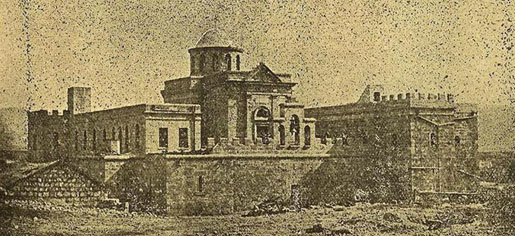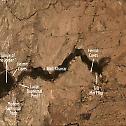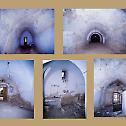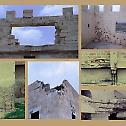The Holy Monastery of St John the Baptist on the banks of the Jordan River
 The Holy Monastery of St John the Baptist on the banks of the Jordan River/Qasr-el-Yahud (PART I)
The Holy Monastery of St John the Baptist on the banks of the Jordan River/Qasr-el-Yahud (PART I)
By Dr Theodosios Mitropoulos, architect
Topography of the area of the Monastery and of the baptismal site (In Arab: El – Maghtas), (images 1,2)
Historical Elements
The history of this Holy Monastery begins in very ancient times, prior to the 4th c. AD. The present-day monastery, which was built in later times, has a rectangular ground plan measuring 37,74 m. x 36,93 m. and occupies an area of approximately 1.343 m2. The perimeter walls, specifically their uppermost portion, terminate at battlements, which lend the monument the form of a Medieval castle. This is in all likelihood why its Arabian name is Qasr el Yahud [The castle of the Jews] (see image 13).
The place-name of the monastery is recorded in the 4th c. on the renowned Madaba map as “THE BAPTISM OF ST JOHN”, on the exact location where according to Jewish and Christian tradition was the site of the crossing of the Jordan river (Bethabara, “place of crossing”) by the tribes of Israel who set out to reach the Promised Land. In the days of the Lord, Bethabara was the name not only of the site but of the entire area where communication took place between those inhabiting the opposite bank of the river (see image 3), where there must have been stations for the receipt of custom, sheds for goods, and a bridge connecting the inhabitants of the area (Perea and Judea). This is the conclusion drawn by most Palestiniologists, due to the discovery of coins from the years of the Maccabees on the opposite shore of the river.
[Beth-Abara. According to KJV version of John, the place was called "Bethabara". In Hebrew this may mean "the house of the crossing" of the river of Jordan. There were many crossings along the river, and a probable place will be closer to the Sea of Galilee.
Beth-Abara is referred in the old testament in conjunction with the Jordan river, so it is very likely to be the same site. In the story of the victory of Judge Gideon over the Midians (Judges 7: 24): "And Gideon sent messengers throughout all the hill-country of Ephraim, saying: 'Come down against Midian, and take before them the waters, as far as Beth-barah, and also the Jordan.' So all the men of Ephraim were gathered together, and took the waters as far as Beth-barah, and also the Jordan"].
In this precise area, where the Lord was baptized by John the Baptist (The baptism of Jesus by John the Baptist is described in Matthew (3:13-17), told briefly in Mark (1:9-11), mentioned in Luke (3:21-22), and implied in John (1:29-34). In these texts John performs an important ritual: announcing that Jesus is the Son of God and the Messiah), a small church must have been founded before the 4th c. Obviously since then the area has been established as a site of veneration in remembrance of the Baptism.
The Madaba Mosaic Map (see image 4) was composed based on the Onomastikon by Eusebius, as well as on knowledge of the Holy Pilgrimage Sites and locations, which were recorded on the map with great precision in terms of their toponymy and survey. On this precise map, the ancient Monastery is depicted on the exact site of the present-day Monastery of John the Baptist. (Theodosius also described the Church of John the Baptist built there by the Byzantine emperor Anastasius I. He said this square-shaped church was built on high arches to allow flood waters to pass underneath. Archaeologists believe they have uncovered remains of the piers on which the church was built).
The ancient topography of the location of the Lord’s Baptism is identified with Evangelic information which report that Jesus Christ, after his baptism in the Jordan river, was“…led into the wilderness to be tempted by the devil”. This same event is also the Christian tradition on the Church of Jerusalem which dates to the 4th c. and has been preserved on the Madaba Map.
Further strong evidence is provided by Origen who in 220 AD studied the Holy Lands and was the first after the Evangelists to refer to the site where the Baptist baptized people and the Lord was baptized by him.
According to the tradition of our Orthodox Church, when St Helena came to the Holy Lands in order to build the All-Holy Church of the Resurrection, she also built a sublime church and guesthouse in honour of the Holy Trinity or John the Baptist, on the Baptismal site (Migne Patr. Vol. 146, p. 113). Subsequent to this event is the construction during the 6th c. AD of two large guesthouses for the pilgrims and the Illuminators, namely monks-catechizers assigned to baptize pilgrims in the Jordan river. Further significant information is mentioned in the Itinerarium Burdigalense [Bordeaux Itinerary] in 333 AD: “Inde ad Jordanem, ubi Dominus a Johanne baptizatus est, millia V. Ibi est locus super flumen monticulus in illa ripa ubi raptus est Helias in celum”. Finally, we should not forget that between 358-360 AD, Basil the Great as well as the then known teacher Eubulus, visited Jerusalem, and were both baptized in the Jordan river, at the then customary baptismal site, by Maximus, Archbishop of Jerusalem.
It is however true that there were other baptismal sites, as recently found by archaeologists, on the opposite bank, where traces have been discovered of an Early Christian Basilica (see image 5), next to baptismal pools especially set for this purpose. (The extensive excavations along the stream bed have uncovered a string of ancient churches and baptismal pools with some remains dating back 1,800 to 2,000 years to the Roman era during or just after Jesus’ lifetime. The churches date back to the Byzantine period, beginning in the fourth century when Christianity first took hold in the region… Yizhar Hirschfeld).
Water for these baptisms probably flowed from the Ain el Kharrar spring, noted on the mosaic map under the name “Ainon” or “Saphsapha”, and poured into the Jordan river, covering a distance shorter than 2 kilometers, exactly opposite the monastery of John the Baptist. (A seventh century pilgrim to the area, John Moschus, noted Jesus’ baptism on the Jordan’s east bank took place near a site called Saphsapha, meaning “Willow.” The same Saphsapha site is noted on the ancient Madaba map in the area of today’s Wadi el-Kharrar excavations). In the area where the spring is found, a peculiar construction is shown on the historic mosaic map. (In 570, for example, the Christian traveler Antonin de Plaisance described a site two miles east of the Jordan River as “the place where the Lord was baptized … and the spring where St. John used to baptize).
Only rightly then does Cyril of Jerusalem preaches that “Water is the beginning of everything and the Jordan river is the beginning of the Gospels”, while the Holy Chrysostom assures that “The beginning of the conquest of earth and the conquest of the Kingdom of Heaven is the Jordan river”.
According to historical sources, the monastery of John the Baptist was ruined during the invasion of the Persians, its monks and other residents slaughtered. Byzantine Emperor Manuel Komnenos (1143-1180 AD) will reconstruct the ruined Monastery which will be preserved until the time of the Crusaders before it succumbs once again to destruction by earthquake.
The earthquakes of 1166, 1168, 1170, as reported by William of Tyre, will cause great destructions, e.g. abandonment of the H. Monastery which, according to information by Ioannis Fokas, will be constructed from its foundations by Manuel the Purple-Born.
The Monastery of John the Baptist will be inhabited by monks until the early 15th century, but after that, successive Arab raids in the region will bring about its dereliction and abandonment. The Monastery will become a refuge for bandits, which will lead the Turkish Government to blow it up. Benjamin Ioannides (The Proskynetarion of the Holy Land, p. 318) reports that among the ruins an ancient icon was salvaged, with the inscription “Here is the lamb of God and we have found the desired one”.
The historical Monastery of John the Baptist before its last destruction by earthquake in 1927
The truth for the detailed construction history of the monument will be revealed once reparation works begin and the archeologist’s spade brings to light more recent elements about its indeed complex and obscure history. It is true that the H. Monastery of the Baptist lies in an area plagued since ancient times by powerful earthquakes, the epicenter of which is found in the Dead Sea. The seismological study of professor Arvanitakis, accomplished during the 19th c., with references on the seismicity of this area of Palestine, is very interesting in this respect because it includes not only the dates of the earthquakes but also their intensity and destructive outcomes (see relevant article on earthquakes in the Patriarchate’s News Gate: http://www.jp-newsgate.net/gr/2012/01/21/5192 ) (see image 6).
Studying the ground plan of the present-day edifice, we can see that it is comprised of five barrel-vaulted areas, where the thickness of the load bearing walls reaches 2 meters. The arrangement of these areas is extended from the east to the west, whilst it has been found that each area belongs to a different construction phase. This specific arrangement, as well as the building style of the underground semicircular arches is reminiscent of the style of the underground areas of the adjacent Monastery of St Gerasimus. From this it may be inferred that these constructions must belong to the same time period.
In 2003, the undersigned was instructed by the Patriarch of Jerusalem to conduct an architectural survey of the monument. During this process, Laser measuring instruments were used, with very good results in the final designing of the plans. The survey (site measurements) which lasted for 15 days was conducted in the presence of Israeli military authorities, as the monument falls today within the Israel-Jordan border, an area mined and barred to the public (see image 7).
Before the devastating earthquake of 1927 the Monastery was a magnificent two-storey building, as shown in a rare photograph from the late 19th c. (see image 8).
On the first floor and at the center of the ground plan of the complex stood the Katholikon of the Monastery, a cross-domed church. Of note was the imposing entrance to the Church, between external piers which decorated the western façade of the monument and supported a vast triangular pediment which lent the monument a strictly classical baroque style.
In the north and south wing of the complex, on the first floor, lie the Hegoumen’s Quarters and the guesthouse, whilst at the southwest corner of the Church, to the right of the central door, stood a double, peculiarly low, bell tower. The dome of the church was shaped after a melon (melonen cupel) while the cylindrical drum bore 10 or 12 windows. Discerned are the battlements which decorated the high perimeter walls and which in their majority have survived to this day.
Almost the entire northern façade of the Monastery, facing towards Jordan, was protected by an immense inclined embankment which in all likelihood was meant to protect the Monastery from projectiles or to reinforce the northern wall against earthquakes. It appears that, because of the 1927 devastating earthquake, the first floor including the Katholikon, the Hegoumen’s Quarters and the guesthouse were completely ruined. An unsuccessful effort followed to reconstruct the Hegoumen’s Quarters and guesthouses with the use of reinforced concrete of very low quality, with the now well-known results (see image 11).
It appears that the idea of the construction of the church above the ground is abandoned, whilst the underground church is still used to this day. At the same time, on the wide roof terrace a dome of small dimensions will be constructed in order to illuminate the sunless underground areas of the ground floor (see image 12). In due time, the webpage of the Patriarchate of Jerusalem will present new elements on the progress of renovation and reparation works carried out at the Monastery.
Dr Theodosios Mitropoulos, Architect of the Church of the Resurrection
HOLY MONASTERY OF JOHN THE BAPTIST
GROUND FLOOR

CHART OF DESTRUCTIONS AND REPARATIONS AT THE HOLY CHURCH OF THE RESURRECTION, JERUSALEM

(By Dr Theodosios Mitropoulos, Architect)
BIBLIOGRAPHY
John 1: 28-34
”These things were done in Bethabara beyond Jordan, where John was baptizing. The next day John seeth Jesus coming unto him, and saith, Behold the Lamb of God, which taketh away the sin of the world. This is he of whom I said, After me cometh a man which is preferred before me: for he was before me. And I knew him not: but that he should be made manifest to Israel, therefore am I come baptizing with water. And John bare record, saying, I saw the Spirit descending from heaven like a dove, and it abode upon him. And I knew him not: but he that sent me to baptize with water, the same said unto me, Upon whom thou shalt see the Spirit descending, and remaining on him, the same is he which baptizeth with the Holy Ghost. And I saw, and bare record that this is the Son of God..”
Matthew 3: 13-17
” Then Jesus came from Galilee to the Jordan to be baptized by John. But John tried to deter him, saying, “I need to be baptized by you, and do you come to me?” Jesus replied, “Let it be so now; it is proper for us to do this to fulfill all righteousness.” Then John consented. As soon as Jesus was baptized, he went up out of the water. At that moment heaven was opened, and he saw the Spirit of God descending like a dove and lighting on him. And a voice from heaven said, “This is my Son, whom I love; with him I am well pleased.” ”
Mark 1:9-11
”At that time Jesus came from Nazareth in Galilee and was baptized by John in the Jordan. As Jesus was coming up out of the water, he saw heaven being torn open and the Spirit descending on him like a dove. And a voice came from heaven: “You are my Son, whom I love; with you I am well pleased.”
Luke (3:21-22)
”When all the people were being baptized, Jesus was baptized too. And as he was praying, heaven was opened and the Holy Spirit descended on him in bodily form like a dove. And a voice came from heaven: “You are my Son, whom I love; with you I am well pleased.”
Source: jp-newsgate.net














